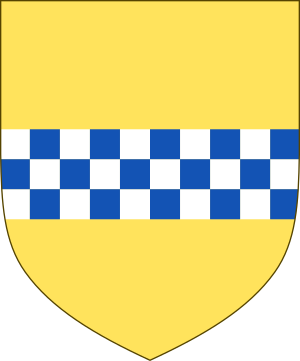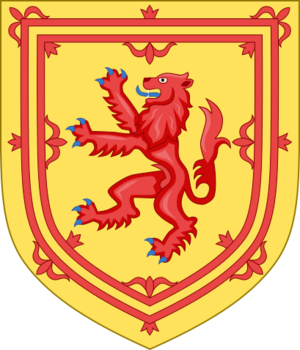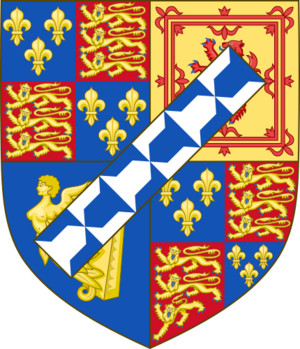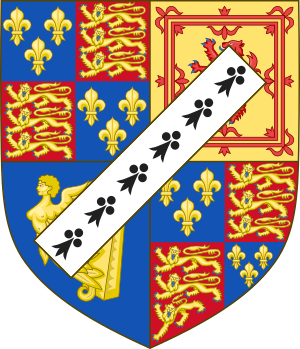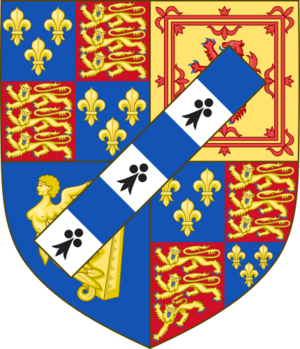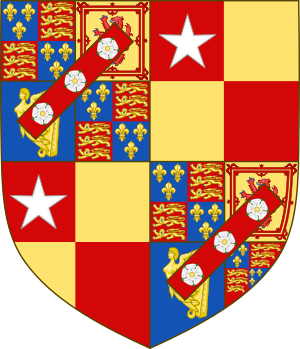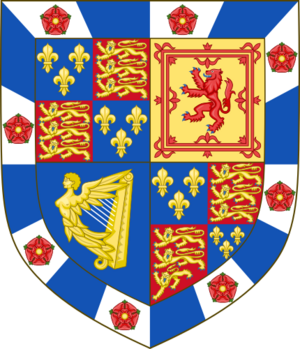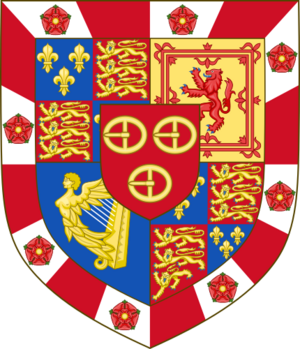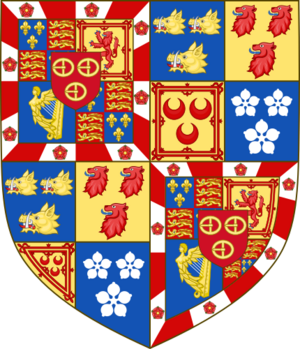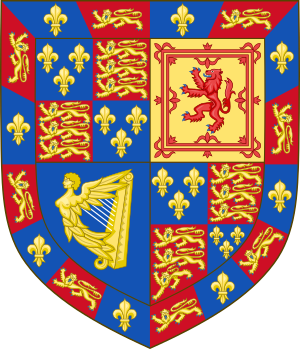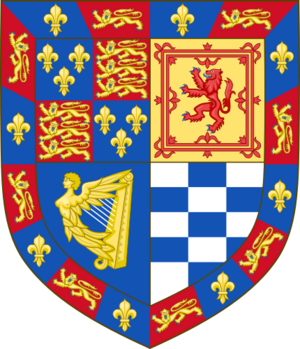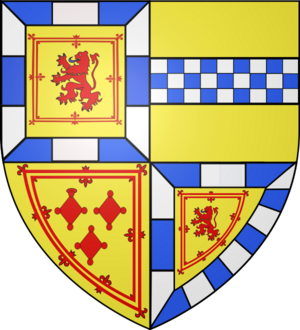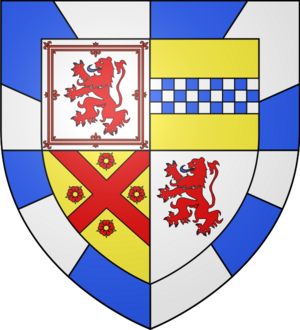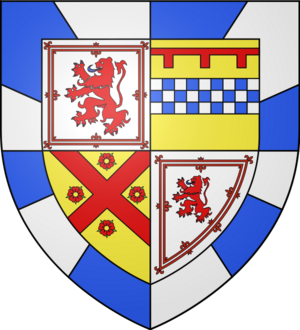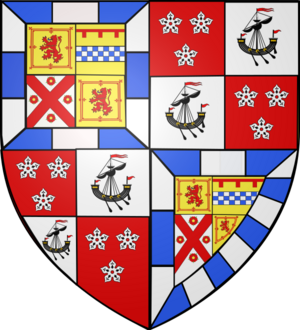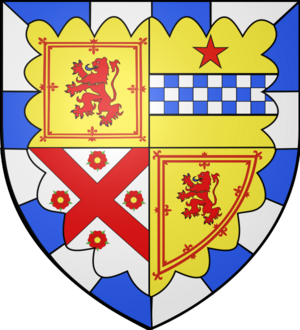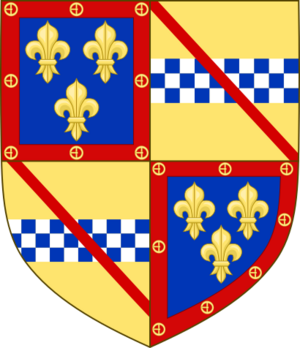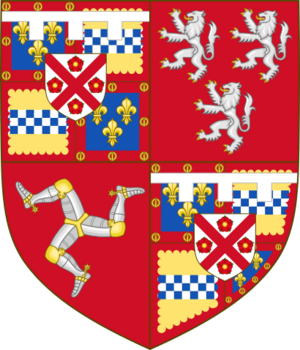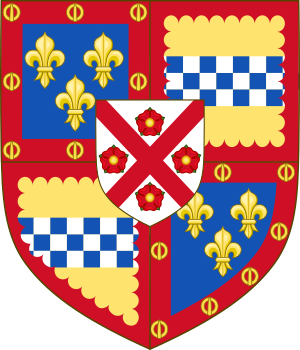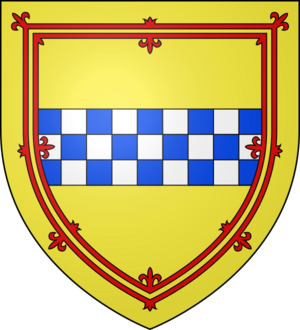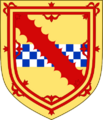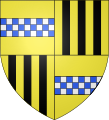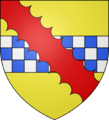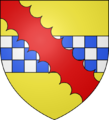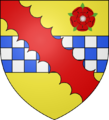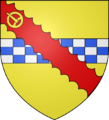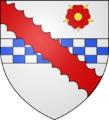Armorial of the House of Stuart facts for kids
The House of Stuart was a very important family from Scotland. Over time, they became the kings and queens of Scotland, England, Ireland, and later, Great Britain! They ruled for many years and played a big part in history.
Contents
The Stewart Family
The Stuart family actually started as the "Stewart" family. They were a powerful clan in Scotland. Their family crest, or coat of arms, was a simple but strong design: a gold shield with a checkered band of silver and blue across the middle. This design is called Or, a fess chequy argent and azure of three rows in heraldry.
The Royal House of Stuart
The Stewarts became the royal family of Scotland when Robert II of Scotland became king. This was the start of the "House of Stuart" as we know it.
Early Scottish Kings
- Robert II of Scotland (1316–1390): He was the first Stuart King of Scotland. His royal coat of arms showed a red lion standing on its hind legs, surrounded by a special border called a "double tressure flory counter-flory." This design is still a symbol of Scotland today.
- David Stuart (born 1356): He was a son of King Robert II. His arms were similar to his father's but with an added red chevron and the checkered Stewart band.
- John Stuart (around 1337–1406): He was another son of Robert II and later became King Robert III of Scotland. His arms had the Scottish lion with a special white "label" across the top, decorated with blue and silver squares.
- Alexander Stuart (1514–1515): He was a young son of James IV of Scotland, who sadly died very young. His arms combined the Scottish lion with the checkered Stewart band.
The Stuart-Lennox Royal Family
This branch of the family became very important when Mary, Queen of Scots, married Henry Stuart, Lord Darnley. Their son, James, united the crowns of Scotland and England.
- James VI Stuart (of Scotland) or James I (of England) (1566–1625): He was the first king to rule both Scotland and England at the same time. His arms for Scotland were the red lion. When he became King of England, his arms combined the symbols of France (three golden lilies), England (three golden lions), Scotland (the red lion), and Ireland (a golden harp).
- Charles Stuart (1630–1685): He was the son of Charles I of England and later became King Charles II. As Prince of Wales, his arms were similar to his father's, but with a white label across the top.
- James Stuart (1633–1701): He was the brother of Charles II and later became King James II. As Duke of York, his arms also had a white label, but with black ermine spots on each point.
- Henry Stuart (1640–1660): He was another son of King Charles I. His arms had a white label with three red roses on each point.
- Mary II Stuart (1662–1694): She ruled as Queen of England and Ireland alongside her husband, William III. Her arms combined the royal arms with symbols from her husband's family.
- Anne Stuart (1665–1714): She was the last Stuart monarch. She became Queen of Great Britain, uniting the kingdoms of England and Scotland. Her arms showed the symbols of England, Scotland, France, and Ireland.
Branches from King Charles II
King Charles II had several children outside of his marriage. These children started new noble families, and their coats of arms often showed a special mark (called a "baton sinister") to show they were descended from the King, but not through the main royal line.
The Scott Family of Buccleuch
This family came from James Scott, 1st Duke of Monmouth, who was an illegitimate son of King Charles II.
- James Crofts (later James Scott) (1649–1685): He was the first Duke of Monmouth and Buccleuch. His arms showed the royal symbols of England, Scotland, France, and Ireland, but with a special white diagonal stripe (a "baton sinister") and a smaller shield on top with the Scott family's own design.
The FitzCharles Family of Plymouth
- Charles FitzCharles (1657–1680): He was another natural son of King Charles II. His arms also featured the royal symbols with a special "baton sinister" that was patterned like ermine fur.
The FitzRoy Family of Grafton
This family came from King Charles II and his mistress, Barbara Palmer.
- Charles Fitzroy (1662–1730): He became the Duke of Southampton and later the Duke of Cleveland. His arms showed the royal symbols with a special diagonal stripe made of six black ermine spots on a white background.
- Henri Charles FitzRoy (1663–1690): He was the first Duke of Grafton. His arms had the royal symbols with a diagonal stripe made of alternating blue and white squares.
- George Fitzroy (1665–1716): He became the Earl and Duke of Northumberland. His arms were similar to his brother Henry's, but with ermine spots on the blue and white squares of the diagonal stripe.
The Beauclerk Family of St Albans
This branch came from Charles Beauclerk, 1st Duke of St Albans, who was a natural son of King Charles II and his famous mistress, Nell Gwynne.
- Charles Beauclerk (1670–1726): He was the first Duke of St Albans. His arms featured the royal symbols with a red diagonal stripe decorated with three white roses.
- Charles Beauclerk (1696–1751): He was the son of the first Duke. His arms combined his father's royal-derived arms with symbols from the de Vere family.
The Lennox Family of Richmond
This family came from Charles Lennox, 1st Duke of Richmond, another natural son of King Charles II.
- Charles Lennox (1672–1723): He was the first Duke of Richmond and Lennox. His arms showed the royal symbols with a border made of alternating white and red squares, with a rose on each white square.
- Charles Lennox (1764–1819): He was the nephew of the 3rd Duke. His arms were similar to his ancestors', but with an added small red shield with three gold buckles on top, representing the Aubigny family.
- Charles Gordon-Lennox (1791–1860): His arms were very complex, combining the royal symbols with the Lennox border, the Aubigny buckles, and symbols from the Gordon, Badenoch, Seton, and Fraser families.
Branches from King James II
The FitzJames Family
This family came from James FitzJames, 1st Duke of Berwick, a natural son of King James II of England.
- James FitzJames (1670–1734): He was the first Duke of Berwick. His arms showed the royal symbols with a border made of alternating blue and red squares. The blue squares had a golden lily, and the red squares had a golden lion.
- Charles Michel Fitz-James (1794–1835): He became the Duke of Alba in Spain. The Dukes of Alba continued to use these arms.
The Stuart Family of Albany
This branch came from Robert Stewart, Duke of Albany, a son of King Robert II of Scotland.
- Robert Stuart (around 1340–1420): He was the Duke of Albany. His arms were divided into four sections. Two sections had a gold shield with a red lion and a blue label, and the other two had a gold shield with a checkered blue and silver band and a blue label.
- Murdoch Stuart (1362–1425): He was the son of Robert Stuart and also Duke of Albany. His arms were more complex, including the Scottish lion, the checkered band, and three red diamond shapes.
- Alexander Stuart (died before 1489): He was a great-grandson of Robert Stuart. His arms included the Scottish lion, the checkered band, and a red cross on a silver shield with four red roses, representing the Lennox family.
- Andrew Stuart: He was the 1st Lord Ochiltree. His arms were similar to Alexander's, with the Scottish lion, the checkered band, and the Lennox roses, all with special borders.
- James Stuart (died 1595): He was the Earl of Arran. His arms were very detailed, combining the Stuart symbols with those of the Hamilton family (three silver cinquefoils and a black ship).
- Alexander Stuart (born around 1557): He was the 1st Lord of Ardvorlich. His arms included the Scottish lion, the checkered band, and the Lennox roses, all with a special border.
The Stuart Family of Darnley
- John Stuart of Darnley: He was an important figure known as a Seneschal. His arms were a gold shield with a checkered blue and silver band, and a red diagonal stripe.
- Alexander Stuart: He was the 1st Earl of Buchan. His arms were a gold shield with a checkered silver and blue band.
- John Stuart (around 1381–1424): He was Lord Darnley and the first Lord of Aubigny. His arms were divided into four sections. Two sections had three golden lilies on a blue background with a red border and eight golden buckles. The other two sections had the checkered Stewart band with a red stripe.
- Lord Darnley (1565–1567): He was the King consort of Scotland, married to Mary, Queen of Scots. His arms were very important as they combined the royal symbols of Scotland and England.
Earls and Dukes of Lennox
- John Stewart (died 1495): He was the 1st Earl of Lennox. His arms combined the French lilies, the checkered Stewart band, and the Lennox family's own symbol: a red cross on a silver shield with four red roses. Many later Earls of Lennox used similar arms.
- Esmé Stewart (1542–1583): He became the 1st Duke of Lennox. His arms were similar to the Earls of Lennox but with different borders. Many later Dukes of Lennox, including Ludovic and James, used these arms.
The Stuart Family of Bute
- James Stuart of Bute (died 1710): He was the 1st Earl of Bute. His arms had the checkered Stewart band, surrounded by a red "double tressure," and also included a red lion on a silver shield.
- John Stuart of Bute (1713–1792): He was the 3rd Earl of Bute and even served as the Prime Minister of Great Britain. His arms were the checkered Stewart band within a red "double tressure."
See Also
Images for kids


